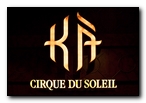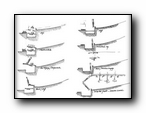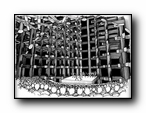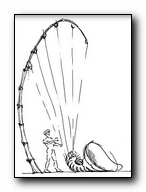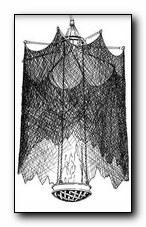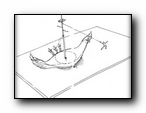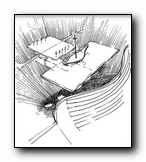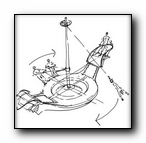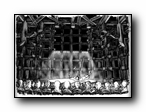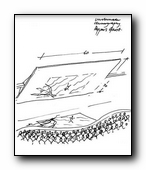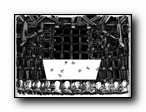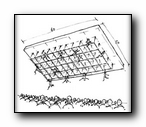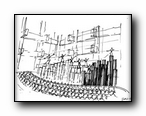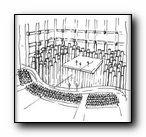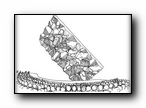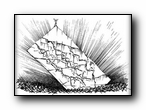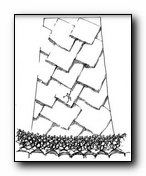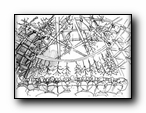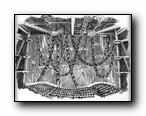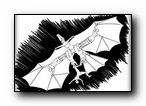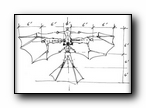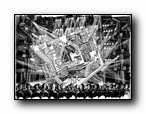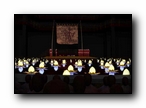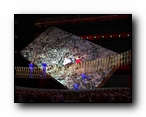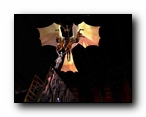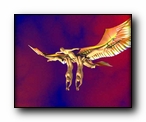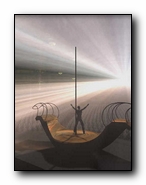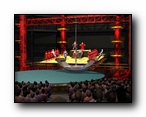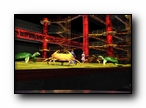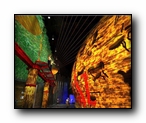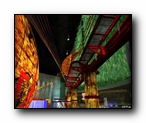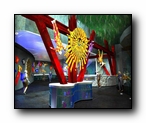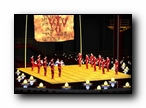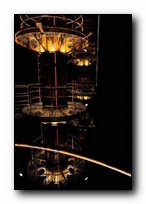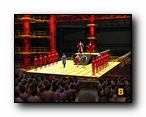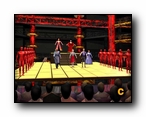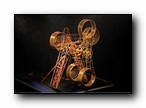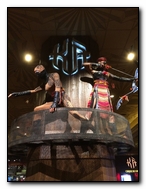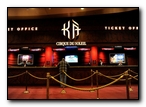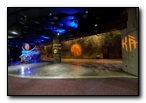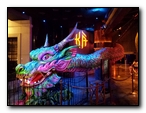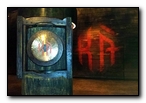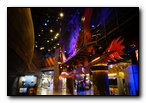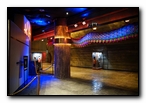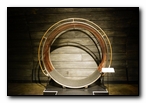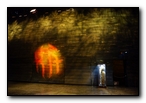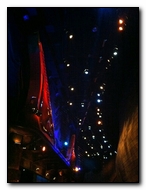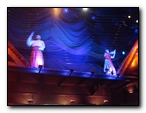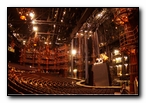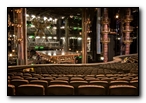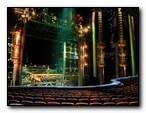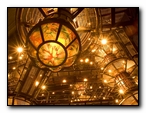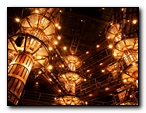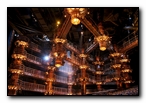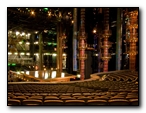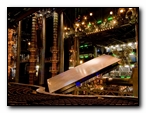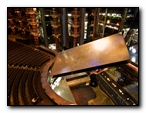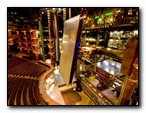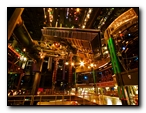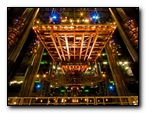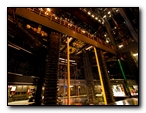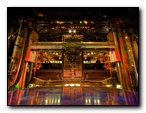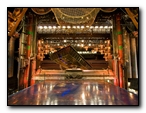
![]()
[ You are here: Grand Chapiteau | Creations | KÀ | Scénographie ]
Création
Expérience
Réserve RetiréOdyssey
The theatre that houses KÀ is a unique space; its most extraordinary aspect may be that it was achieved within the confines of an existing building. The former home of EFX (itself the most expensive and largest-scaled theater installation in the world) was reduced to a shell and a completely new theatre and lobby put in its place. First, the floor area of the stage was removed, creating an abyss housing the five stage lifts, resulting in a total of 4,950 sq. ft. of flexible staging area. Next, the theatre configuration was altered, from a cabaret space filled with booths, tables, and chairs, to a theatre that seats 1,951 audience members. And then, a new set of catwalks and grid decking over the seating area was added for performer access and lighting and technical systems in the front-of-house area. The control booth was reconfigured to allow space for the production’s extensive lighting, audio, projection, and automation controls. The control suite features 2,850 sq. ft. of booth space and 170 linear feet of glass; it offers a view of the entire performance area. Meanwhile, the building’s infrastructure had to be totally reworked to accommodate the production’s extensive technical needs. All spaces, including rehearsals halls, technical offices, training rooms, dressing rooms, shoe and costume maintenance areas, green rooms, and a new annex (housing Cirque du Soleil offices, support facilities, and a rehearsal room with a full-span overhead gridiron) were interconnected with sound, video, and communications from the stage area. New structural supports were added for the extensive automated rigging system, including an 82-foot long hoist-support structure in the arbor pit, as well as a 37-foot long “battle-hoist” structure on the grid. A series of new company switches and equipment power were distributed throughout the theatre, for chain hoists, special effects, and specialty equipment. And a new multi-tiered rigging system was developed at the grid level to allow for sophisticated stage automation systems. (Jaque Paquin conceptualized and designed, with Pierre Mase the theatre’s rigging and acrobatic systems; project manager Jeremy Hodgson, working with Tom Neville of Auerbach, developed the system). Also, three high-speed data and communications networks were installed in the space. But we're getting a little ahead of ourselves here. Suffice it to say, everything had to be reworked from the ground up... quite literally. Collaborating with Cirque du Soleil's creative team, UK-based architect Mark Fisher served as both designer of the theatre and the scenic elements for KÀ. Nearly three years before the show premiered, Fisher met with Robert Lepage, KÀ's French-Canadian director, learning about Lepage's vision of an epic tale spiced with Eastern (India, Asia) flavor. He then went home and began his design process. One of his first references was Kiyomizu temple in Kyoto, Japan that stands on an enormous palisade of tree trunks. “I was not interested in the temple itself,” Fisher says, “but rather the structure under it. Imagine if the theatre was carved into a structure like that.” His idea of carving out a space translated into a vast, cathedral-like theatre. In October 2002, Fisher presented a computer animation, with a dramatic wooden post and beam design, to Cirque founder Guy Laliberté, Lepage, and other members of the theatre design team. Everybody said, “yes, we'll have one of those please,” Fisher recalls. The final look is “industrial Baroque” with four levels of posts (vertical pillars) and beams (metal catwalks) embracing the show, and serving as an infinite number of performance platforms. Fisher, known for his big, flashy rock concert sets, made a conscious decision to design the stage, set, and auditorium together as an integrated concept. The thematic voyage extends right into the lobby. “The idea was to create a promenade of theatrical spaces that made the transition from the casino to the theatre,” says Fisher. Here glass doors lead from the casino into a foyer, and into another world, adding to the myth that all this was there before Cirque du Soleil discovered it. Guests enter from the casino into a dark, low-ceiling space with lights the color of glowing embers. Large tree trunks, banded with light, marks the edge of the main lobby, where the ceiling soars to expose the full height of a wall, which appears to be an inverted ancient ship’s hull. Colored light plays on the surface of the vessel wall. Before the performance, musicians located in the trees play the strings of a giant harp. The main lobby theatrical lighting is provided by ETC units, using color and pattern projectors to light the floors, metal mesh wall curtains, and stringed harp. ETC Source Four Zooms light the vessel wall. Other Source Four Zooms with gels light the lengths of the harp strings. Mole-Richardson Nooklites mounted to the exposed structural beams are inspired by the Post and Beam design. Surface mounted MR16 monopoints, by BK Lighting, are recessed into the floor to reinforce the shape of the curved glass wall and uplight the glass fins. Openings in the vessel wall led to the concession counters and public rest rooms. These spaces have an industrial feel, with metallic painted finishes and glow acrylic panels in the ceiling, walls, and the fronts of the counters. Fluorescent strips with dimming ballast and T8 lamps are mounted so as to be visible behind the acrylic panels. Prescolite recessed adjustable MR16 downlights with colored lenses light the counters. Compact Shaper Lighting fluorescent sconces with dimming ballast create a sense of glowing portholes leading to the rest rooms. Entering the audience chamber from the lobby, one passes through a sheet of saturated blue light into a glowing blue entry vestibule. The blue light is created by a fiber-optic narrow beam wall-grazer by Glass Illuminations mounted in the ceiling behind the first set of doors. Mounted on the ceiling line at the side walls are Color Kinetics ColorBlaze fixtures with blue LEDs to fill the void with blue light. Recessed Prescolite adjustable MR16 units with blue glass filters provide pools of light at the entry doors. In the audience chamber, the ramp is lit with Architectural Area Lighting Occulus fixtures above the entry doors. Architectural MR16 and PAR lamp fixtures are integrated into the Post and Beam structures. The house lighting system uses Kurt Versen fixtures mounted halogen downlights, each customized with a yoke and top relamping feature. The fixtures are mounted to the technical catwalks above the house and have narrow or medium distributions based on throw distances. ETC Source Four PARs mounted to the Post and Beam structure and Prescolite recessed adjustable downlights under the control booths supplement the catwalk fixtures to provide uniform lighting. Bega low-voltage halogen step lights are recessed into the walls for egress lighting. Tivoli warm white LED seat lighting, on dimmers, provides egress lighting during the performance.
The rise to the seating is gradual so that people cannot see into the abyss when they enter. Entrance ramps on both sides of the auditorium create an aura of surprise as the audience enters the 1,951-seat space. “We raised the ceiling and the proscenium height to exaggerate the sense of verticality,” says Fisher. "If I wanted to achieve anything -- you just want people's jaws to drop. In this room I wanted that moment to be when you come up the ramp, turn the corner and you just go 'I don't believe it.'" Lafortune illuminated the post and beam construction, using 600 Color Kinetics Color Blast LED fixtures and 750 Mole Richardson single cell Molefay fixtures, whose signature maroon color blends with the oxidized red of the pillars themselves. The Color Kinetics fixtures were also custom powder-coated in Mole Richardson red. More than 1800 fixtures are integrated into the post and beam construction including internal fixtures (A-lamps), which illuminate the “crystals” on the bottom of each post. By placing so many small, discreet sources in the posts and beams, a number of different looks can be created. “It can [appear] like a Japanese temple or an iron foundry or even a jail when the railings are lit in cold white to emphasize the steel,” he says. At one point, the posts are lit internally with ETC Source Four Parnels, adding a green glow as drummers perform on the exterior of the catwalks. To replace the stage, Fisher designed a floating deck, referred to as the sand-cliff deck. Measuring 50-feet wide by 25-feet deep and 6-feet tall, it was engineered by M.G. McLaren and built by Tomcat USA. It consists of seven steel main structural pieces, six aluminum I-Beam deck frames, 10 cladding frames, 10 catwalk components, three elevators, 18 nosing deck frames, and 15 aluminum acrobat rail frames, and 80 individually controlled 24-inch-long pegs. Airbags and performer safety nets deploy when the deck is moving. The deck attaches to a center hub that is supported on a “wrist and arm” assembly cantilevered from a torsion tube. The tube spans between two support columns 86-feet apart that extend from the basement to the upper catwalk level. The hub is 10-feet in diameter and allows the deck to spin 360° and tilt vertically up to 100° (more “forward” than 90°). It can also lift, tilt and spin simultaneously. The gantry crane and Sand Cliff Deck are powered by five 250hp pumps and 3500 gallon oil reservoir. The entire deck/gantry assembly weighs between 280,000 and 350,000 lbs. (unloaded) and can be lifted at a rate of 2' per second. And behind all this is a scrim (a sheer black curtain) that measures 75-feet tall by 140 feet wide. Inside the deck are three circular elevators five feet in diameter. There is also a systems of access tunnels, show and work lights, drive units for elevators, high-voltage 480V and 208V distribution panels, lighting dimmers, and storage areas. Mounted in the deck surface are 80 individually controlled pegs that pop out of the deck surface for acrobats to use and climb up the deck when in a vertical position. When horizontal, the deck can hold synthetic “sand” (made of ground cork), with 3-inch sand-retaining actuators holding the sand in place, but when the deck tips the sand can be dumped. There are acrobat rails on all four sides, and the surface of the deck is a painted scenic treatment with projection tiles. Everything was built and test fitted at Tomcat. The deck has a self-weight of 90,000 lbs. and had to be broken down and shipped out on six flat bed trucks. The torsion tube and wrist and arm assembly for the deck were built by Timberland Equipment, a company that normally builds mining equipment. Some of the thoughts that went into the creation of the set include the idea of "doing away with gravity, to some extent -- and so the idea of a void came out of that." Cirque spent $12 million US on the stage alone. "Robert wanted to do a show about gravity, to change the perspective of the people," Mongeau said. "At one point they felt the seats could go back and the audience could look up in the air." That idea was rejected. "But he always wanted to change the perspective of the audience," Mongeau said. “The deck is the conceptual answer to the void,” says Fisher. “Lepage wanted a sequence of cinematographic scenes with disorienting points of view that would defy gravity. The result is a deck that floats in space.” There is also a Tatami deck (built by Show Canada) that serves as a B stage, sliding open to allow scenes to c rossfade. It measures 30x30 feet and weighs between 75,000 to 100,000 pounds. The Tatami Deck can slide forward almost 50 feet at full travel, like a giant sliding drawer. At its full extension, it appears to float over the abyss. It runs on two electric motors and uses hydraulic brakes. Five smaller, odd-shaped lifts by Gala surround the two main decks and are used for maintenance and performance. The consultants at Auerbach • Pollock • Friedlander collaborated here on rigging, stage lifts and machinery, lighting, sound, and automation control for the stage lifts and floating deck. “There is a master rigging control system, for all of the automation in the show. This interfaces with the hydraulic control system for the gantry, the 26 motors for the stage lifts, and all the hoists and pegs. There are approximately 223 axes of control,” says S. Leonard Auerbach, ASTC, senior design principal of the firm. Fifteen control points, where any of five remote Nomad consoles by Stage Technologies, as well as with two hand-held remote consoles, can be plugged in, provide multiple options for automation operators. Rigging includes 120 line sets from JR Clancy, with 40 Big Tow winches by Stage Technologies, used for flying of specific scenic elements. Sophisticated acrobatic rigging was designed in collaboration with Cirque du Soleil's acrobatic rigging designer Jaque Paquin. “The exciting thing about the rigging is a series of 16 high-speed battle hoists from Stage Technologies (higher speed than the Big Tows) that allow the performers to walk up the deck wall when it's vertical, straight up and down, parallel to the floor,” says Neville. “The performers control their direction and speed via wireless control pendants attached to their costumes, which include special harnesses.” One of the biggest challenges for Lafortune is the fact KÀ is more literary and story-driven, another first for Cirque du Soleil, which he admits to finding a little intimidating in the beginning. “The process was more like theatre than I am used to, and the script served as a catalyst for design choices. I quickly realized that Robert Lepage is a man of words. He also works with continuity and a chronological order. My work is more intuitive,” he says. The story is Shakespearean with twins, separation, conflict between groups of people, the fight for survival, and coming of age. "I wanted to define the two different worlds: that of the protagonists in the emperor's court and the antagonists who are the rival archers." Finding himself in a literary ambiance with script in hand, Lafortune decided to write his own lexicon, including words of inspiration to help define each of these worlds. For the emperor's court, the primary words were water, wood, and paper, further honed by such descriptions as a summer night, floating, ephemeral, lightness, thinness, warmth, lanterns, and incandescent light sources. In contrast, the archer's den was defined principally by metal, with such adjectives as industrial, solid, structural, oppressive, heavy, immense, monolithic. In contrast to the warm incandescent glow of the court, the archers were bathed in the cold, ugly glare of arc sources. Lafortune also looked to images to put these words into a visual vocabulary as well. For the archers' environment, he was dawn to images of refineries at night with glowing green light, transposed on stage as 48-inch green neon tubes by Encapsulite. “The archers are not aesthetic. They live in a cold metallic world and are motivated by meanness,” says Lafortune, who sat with Lapage and showed him his collection of images, including rippling reflections of water and iron foundries. “We kept some and discarded some until we agreed on the inspiration for the show.” The images helped define the look for each environment, which were then transposed into lighting fixtures and colors that would convey them. "KÀ is very cinematic, so I looked to films for inspiration as well,” notes Lafortune, who mixed a DVD of scenes from a range of films, from Sally Potter's Orlando and Peter Greenaway's Prospero's Books to sunlight reflected on the bottom of the ocean in Pirates of the Caribbean and the industrial quality of Blade Runner. Some of the industrial sources include 400W Mariner SFMM floodlights by Hubbell. “These have high-temperature HTI arc sources as are used in parking lots,” says Lafortune, who adds that these fixtures are used with mechanical dowsers to overcome the long strike time. He also opted for 5000W Mole Richardson Molebeam projectors to serve as backlight followspots. “I wanted the look of followspots without the ellipse of the followspot light in the air,” he adds. These are used with the “toothy” Wybron Eclipse dowsers. “A perfect look for the archer's environment,” says Lafortune. From the very beginning of the show, Lafortune creates lighting that draws the audience in. A twinkling effect is created with 12 Selecon Pacific luminaires with 575W MSD light sources, fitted with customized City Theatrical EFX Plus3 effects machines. “The look is like the Northern Lights. It is ethereal and aquatic,” notes Lafortune. During a stormy shipwreck scene, with powerful Lightning Strikes strobes flashing along the proscenium, realistic cloud projections were added (on a scrim) by mixing clouds from front-of-house Barco projectors with cloud effects wheels on the Selecon fixtures. Although fire is a main theme of KÀ, the color red is used very judiciously. One scene where red light is used effectively is in the battle scene, where the performers are fighting on the sand-cliff deck in a vertical position with extraordinary projections timed to their movements. Here, the red is clearly the color of blood and battle. The projections, designed by Holger Forterer, are abstract and nicely integrated with the lighting and scenic elements. In the battle scene, the archers are lit by the projections on the vertical deck, while the principals are lit with followspots, creating interesting layering in the light. “The deck is moving, so sidelight is not possible,” says Lafortune. “When the deck is completely vertical, the light casts shadows that are larger than life and very menacing.” By far, the brightest scene is on a beach, where crabs pop out of the sand and a starfish dances jauntily (articulated costumes courtesy of designer Michael Curry). “The idea is that you need sunglasses, and there is a reflection of the sun on the sand and the water,” says Lafortune, who used a row of PARs to backlight the performers from behind, with additional sidelight to accent the sand. Followspots help pick out the creatures and actors from the sandy background. All of the followspots are 2500 HMI D'Artagnan by Robert Juliat, and positions include the lighting booth, a mid-house catwalk position for a steeper angle, and at the proscenium. Altman beam projectors in the basement are used to light translucent fabric birds that flutter over the audience as a transition to the beach scene. “The birds are only lit from below,” says Lafortune. “There is nothing above them but the stratosphere.” The lighting also has various textures and layers, from icicle gobos in a blizzard scene where falling snow twinkles against the black abyss, and a more whimsical look for a forest scene with split gobos of green and yellow, or a faint blue wash on galvanized metal pipes that track in as trees. There are also projections of concentric moving lines that add yet another layer. These scenes are equally lit from above with steep back angles (rather than straight overhead positions) and below with a lot of gear in the basement. He also points out that the “residue” lighting has to “die” in the abyss, as there is no room in the wings. One of the harshest scenes is the construction of the Wheel of Death, a large acrobatic apparatus that is later used by acrobats who defy gravity as they fly around the moving wheels. As the evil archers are “constructing” this torture machine, real sparks are flying, and the entire stage area is empty, with the performers suspended on a catwalk over the void. Added to the evilness are the green neon tubes, PAR94 nine lights and 4kW HMI fixtures upstage on catwalks. “The theatre is the decor,” he says. “The masking is gone; there is no deck and no tatami mat. All of the catwalks are visible all the way to the top of the theatre, and there are lights everywhere including on the hoses for the hydraulic system and the steel columns of the theatre.” To accomplish all of this, Lafortune and his lighting team, including associate lighting designer Nol van Genuchten, lighting director Jeanette Farmer, moving light programmer Hubert Tardif, and many others, spent 11 months in the theatre, starting in March 2004. Tardif programmed the moving lights on a Flying Pig Systems Wholehog 3, while Lafortune programmed the conventional lights himself on a Strand 550 console (more on this in a bit). Ethernet taps throughout the theatre, and Strand's ShowNet system, add to its complexity and ultimate flexibility, as the installation is one of the largest and most complex theatrical lighting networks ever designed for a single venue. A completely new dimmer system was installed, consisting of 24 Strand SLD series dimmer racks in three dimmer rooms. Two thousand twenty-six 20A dimmers and forty-five 50A dimmers are network-controlled. All dimmers are status-reporting, with local PCs running Reporter Pro for this purpose in each dimmer room. In addition to the main dimmer racks, two remote dimmer packs are located in the Sand/Cliff Deck and are controlled via wireless Ethernet. There is extensive distribution of 20A and 50A dimmed circuits, utilizing custom-fabricated plug boxes. A wide-ranging system of cable trays was installed throughout to allow multi-cable distribution from these circuit boxes to virtually any light fixture hanging in the theatre. Emergency power transfer to selected architectural circuits is handled with six 24-circuit, UL 1008-compliant emergency transfer panels. All networked power circuits for consoles, PCs, and other sensitive computer grade components are on dedicated centralized UPS circuits. A large system of switched loads of 120V single phase and 280V single-phase are distributed throughout the theatre and are under network control. Lighting control is provided by two Strand 550i 54-submaster consoles, each with 6,000 channels and quad video displays; four Strand 520i 24- submaster consoles with 6,000 channels and dual video displays; two Strand 510i rack-mount consoles with 6,000 channels, and two High End Systems Wholehog II consoles with Strand ShowNet network nodes. Forty universes of DMX can be mixed and matched to any of the 100 double- network taps distributed throughout the theatre. Sixty portable SN 110 nodes are available, all using power over Ethernet ports. There are five wireless data access points allowing use of handheld wireless remotes, and/or a remote wireless notebook for console video displays anywhere in the theatre. (Michael Lay was project manager for Strand). All network equipment is housed in nine racks interconnected with three fully redundant fiber-optic backbones. All network switches/hubs are managed and patch bays are included for all taps and nodes. AMX-based card racks are also located in the racks for use of touch screens for network, house, and work light controls, and network video distribution electronics for touch screen feeds. In addition, the racks include space for system file servers and rack-mount consoles. Remote AMX-driven color touch screens, in both fixed and portable configurations, are located throughout the theatre for use by stage managers and lighting technicians to control cue lights, rehearsal lights (featuring digital virtual sliders) and to view remote stage video feeds. "Much of the system is software-driven and not fixed due to hardware,” says system designer Larry French of Auerbach • Pollock • Friedlander. “It is very unusual and very cutting-edge. They have pushed the limits as far as they can be pushed. In terms of routers, switchers, hubs, nodes, and back-up systems so that the show can go on no matter what, this is one of the largest managed networks ever created.” Jonathan Deans, Cirque du Soleil's veteran sound designer, collaborated with Paul Garrity of Auerbach • Pollock • Friedlander on the design and integration of the custom surround sound system in the KÀ theatre, and acousticians from Pelton, Marsh, Kinsella (Dan Saenz for room acoustics and George Kindler for the LCS VRAS system). “There is an entire studio in the basement so musicians can play in a controlled environment and watch the show on a large-screen monitor,” says Garrity. “They can also leave the room and play, connected via in-ear monitors.” But the real challenges for the audio include the sheer size of the venue and the fact that the performance area is continually moving.
The sound design for KÀ utilizes a total of 4,774 individual loudspeaker drivers placed in a total of 2,139 boxes. The mixing console, which is a large LCS system utilizing the Cue Console, includes a show file which, to date, has 1.5 million control points. The RF system is immense. The “RF world” above the stage in a wireless room close to the grid is where technician Gary Tendi looks after the RF systems. A basement equipment room serves as the heart of the sound system control. As Deans explains, “the audio is no longer next to the sound man. The control is via Ethernet.” In this case there is a Level Control Systems virtual console at the in-house mixing position for digital control. Solotech from Montreal supplied the sound equipment with Bob Barbagallo serving as project manager. There are 246 carriers used in the show which, when added to the building and other local RF brings the total frequency coordination to 622 carriers! Telex mentioned to me during the recent ETS-LDI show in Las Vegas that KÀ is using 44 drops of their BTR-800 systems, which is unprecedented. Using software developed by David Rokeby known as VNS or “Very Nervous System,” Deans has been able to integrate interactive sound effects into a Cirque show for the first time. A video picture of the performance area is processed via the VNS software and allows the user to designate a grid-work of zones within the live picture. If movement is detected within a particular zone, the software is able to transmit data to the LCS system which triggers audio. The creativity that this software inspires is endless and it is a perfect fit to a Cirque show. LCS itself is about as cutting edge a mixing and playback system as you can get. Three separate LCS Matrix3 systems are deployed here: two LCS CueConsole modular mixing consoles–one for FOH mixing and one for monitors mixing–provide the precise control and automation needed for the complex sound design. The third LCS system is equipped with VRAS (Variable Room Acoustic System) and provides seven different zones of room acoustic enhancement, used for both effects and for generating a more personal and intimate listening experience for the audience, no small feat considering the immense size of the new theatre. The sound design of KÀ makes extensive use of Space Map‚ a unique feature built into LCS’ CueStation programming software for Matrix3. Space Map is a custom panning surface that gives KÀ intuitive control of over 150 channels and over 4000 loudspeakers. A project programmed with CueStation software can have any number of Space Maps, which can be used for different sound sources and sets of loudspeakers at different points in the show. One of the benefits of this technique is that Space Map adapts to the loudspeaker layout, rather than the other way around. Sound designers can determine the loudspeaker locations first, and then program one or more Space Maps appropriate to the show. Movements of sound are programmed as trajectories, and then triggered in a cue by an operator pressing a button, or by timecode reaching a designated point. Every input in the console can be panned independently at any time. The FOH system at KÀ includes fourteen LX-300 system frames providing Ethernet control of 152 inputs and 184 outputs via a modular LCS CueConsole mixing desk. Every piece of hardware within the LCS setup has an IP address and communications take place over CAT5 cable. For monitors mixing, KÀ employs eight LX-300 system frames with 128 inputs and 64 outputs and a second CueConsole mixing desk, also connected via Ethernet. The VRAS system is comprised of an additional eight LX-300 system frames, seven of which incorporate the VRAS option, and provide forty inputs and 144 outputs, making it the largest VRAS system to date. |


